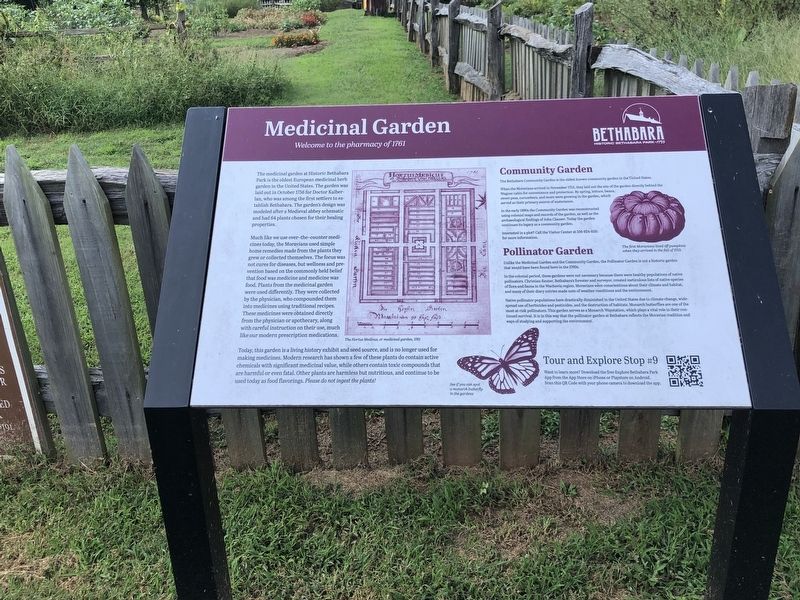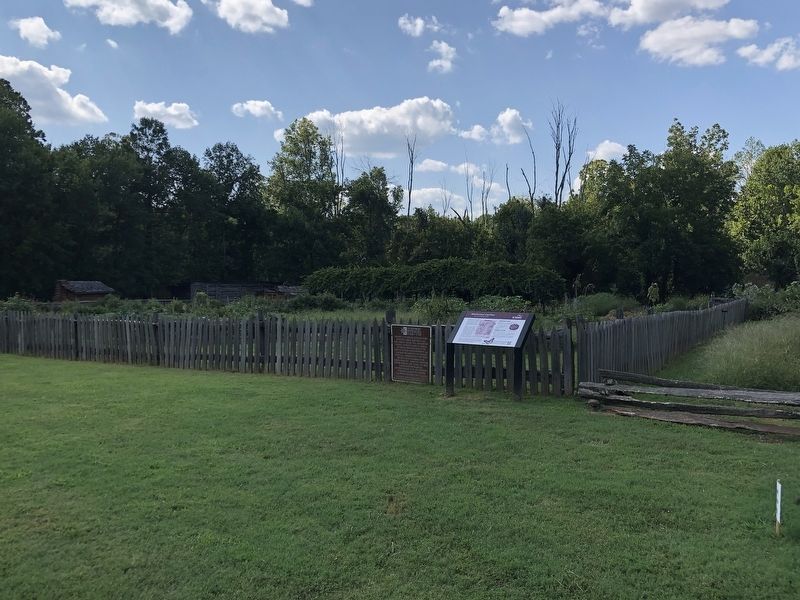Oldtown in Winston-Salem in Forsyth County, North Carolina — The American South (South Atlantic)
Medicinal Garden
Welcome to the pharmacy of 1761
Much like we use over-the-counter medicines today, the Moravians used simple home remedies made from the plants they grew or collected themselves. The focus was not cures for diseases, but wellness and prevention based on the commonly held belief that food was medicine and medicine was food. Plants from the medical garden were used differently. They were collected by the physician, who compounded them into medicines using traditional recipes. These medicines were obtained directly from the physician or apothecary, along with careful instruction on their use, much like our modern pescription medications.
Today, this garden is a living history exhibit and seed source, and is no longer used for making medicines. Modern research has shown a few of these plants do contain active chemicals with significant medicinal value, while others contain toxic compounds that are harmful or even fatal. Other plants are harmless but nutritious, and continue to be used today as food flavorings. Pease do not ingest the plants!
Community Garden
The Bethabara Community Garden is the oldest known community garden in the United States.
When the Moravians arrived in November 1753, they laid out the site of the garden directly behind the Wagner cabin for convenience and protection. By spring, lettuce, beans, sweet peas, cucumbers, and more were growing in the garden, which served as their primary source of sustenance.
In the early 1990s the Community Garden was reconstructed using colonial maps and records of the garden, as well as the archeological findings of John Clauser. Today the garden continues its legacy as a community garden.
Interested in a plot? Call the Visitor Center at 336-924-8191 for more information.
Pollinator Garden
Unlike the Medicinal Garden and the Community Garden, the Pollinator Garden is not a historic garden that would have been found here in the 1760s.
In the colonial period, these gardens were not necessary because there were healthy populations of native pollinators. Christian Reuter, Bethabara's forester and surveyor, created meticulous lists of native species of flora and fauna in the Wachovia region. Moravians were conscientious about their climate and habitat, and many of their diary entries made note of weather conditions and the environment.
Native pollinator populations have drastically diminished in the United States due to climate change, widespread use of herbicides and pesticides, and the destruction of habitats. Monarch butterflies are one of the most at-risk pollinators. This garden serves as a Monarch Waystation, which plays a vital role in their continued survival. It is in this way that the pollinator garden at Bethabara reflects the Moravian tradition and ways of studying and supporting the environment.
[Captions clockwise from left)]
• The Hortus Medicus, or medicinal garden, 1761.
• The first Moravians lived off pumpkins when they arrived in the fall of 1753.
• See if you can spot a Monarch butterfly in the gardens
Erected by Historic Bethabara Park. (Marker Number 9.)
Topics. This historical marker is listed in these topic lists: Environment • Horticulture & Forestry • Science & Medicine. A significant historical month for this entry is October 1756.
Location. 36° 9.365′ N, 80° 17.94′ W. Marker is in Winston-Salem, North Carolina, in Forsyth County. It is in Oldtown. Marker is at the intersection of Bethabara Road and Bethania Station Road, on the left when traveling west on Bethabara Road. Touch for map. Marker is in this post office area: Winston Salem NC 27106, United States of America. Touch for directions.
Other nearby markers. At least 8 other markers are within walking distance of this marker. Medical Gardens 1761 (a few steps from this marker); Community Garden 1759 (a few steps from this marker); Historic Bethabara Park 1753 (a few steps from this marker); Summerhouse 1759 (within shouting distance of this marker); New Tavern Well 1755 (within shouting distance of this marker); New Bethabara Tavern 1775 (within shouting distance of this marker); Community and Medical Gardens (within shouting distance of this marker); Mill-Wright's House 1762 (within shouting distance of this marker). Touch for a list and map of all markers in Winston-Salem.
Also see . . . Moravian herbs and ways they are used. Brother Christian Gottlieb Reuter’s hand-drawn renderings of the medicinal garden were discovered, dating back to June 1761. During this time, imbalances (or humors, although it's no laughing matter) acted like today’s over-the-counter medicines. (VisitWinstonSalem.com, March 13, 2023) (Submitted on October 16, 2023, by Duane and Tracy Marsteller of Murfreesboro, Tennessee.)
Credits. This page was last revised on October 16, 2023. It was originally submitted on October 5, 2023, by Duane and Tracy Marsteller of Murfreesboro, Tennessee. This page has been viewed 54 times since then and 9 times this year. Photos: 1, 2. submitted on October 5, 2023, by Duane and Tracy Marsteller of Murfreesboro, Tennessee.

